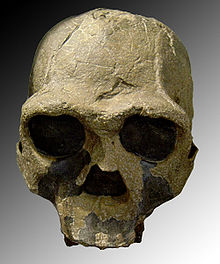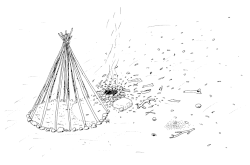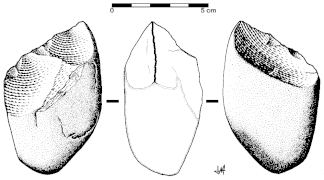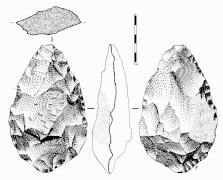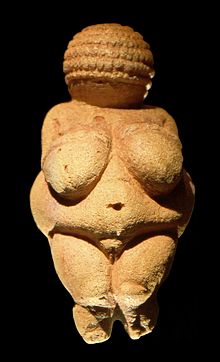Paleolithic
The Paleolithic (from the Greek παλαιός, palaiós: 'ancient', and λίθος, lithos: 'stone') is the most throughout the existence of the human being (in fact it covers 99% of it) and extends from about 2.59 million years ago (in Africa) until about 12,000 years ago. It constitutes, together with the Mesolithic/ Epipaleolithic (transition phases) and the Neolithic, the so-called Stone Age, so named because the elaboration of lithic tools has served archaeologists to characterize it (as opposed to the later Metal Age). The term Paleolithic, etymologically "old stone", was created by archaeologist John Lubbock in 1865, as opposed to Neolithic or "new stone".
Although this stage is identified with the use of carved stone tools, other organic raw materials were also used to build various artifacts: bone, antler, wood, leather, plant fibers, etc. During most of the Lower Paleolithic, stone tools were thick, heavy, clumsy, and unwieldy, but over time they became increasingly lighter, smaller, and more efficient. Paleolithic man was nomadic, that is, his life was characterized by continuous or periodic (seasonal) movement.
Periodization
Approximate correlation of the geological temporal scale with the Paleolithic and its divisions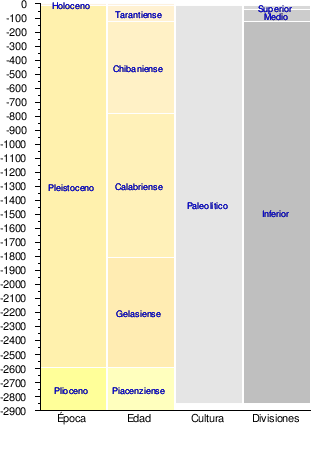 Scale in thousands of years. |
The Paleolithic has traditionally been divided into three periods:
- Lower paleolithic, from about 2.85 million years to 127 000 years before the present (AP), covering part of the Pliocene and the first three floors of the Pleistocene: Gelasiense, Calabriense and Chibaniense (formerly the second was known as Lower Pleistocene and the third as Middle Pleistocene);
- Average palleolithic, up to 40 000-30 000 AP years, which means almost the entire Tarantiense (time ago, Upper Pleistocene);
- Upper Palaeolithic, up to about 12 000 AP and therefore almost all the rest of the Tarantiense (formerly, Upper Pleistocene).
This periodization is only valid in its entirety for Europe and the closest areas of Africa and Asia. For the rest of the Old World and America, different periodizations have begun to be developed, but no consensus has yet been established regarding their use.
Paleolithic Humans
Since the Paleolithic was identified with the use of stone tools by the known species of the genus Homo, a large part of our hominin ancestors, such as Australopithecus, fell outside their scope of study. They are considered within:
- Homo habilis, his first representative, had a cranial capacity of 600-800 cm3, measured between 1.2 and 1,5 m high and weighed about 50 kg. He lived in Africa 2.5-1.6 million years ago.
- Homo rudolfensis, located only in East Africa, was about 750 cm3 and between 2.4-1.9 million years old. He is subject to controversy, believing some authors that he would belong to H. habilis.
- Homo ergasterHe was the first to emigrate from Africa. With about 850 cm3 of encephalic capacity and between 1.8-1.4 million years, it is the African predecessor of the H. erectus.
- Homo georgicus, with an encephalic capacity of 650 cm3 and 1.6 million years, has been identified only in Georgia. Some authors consider it H. ergaster.
- Homo erectus, with 900-1100 cm3, used Asia between 1.8-0.2 million AP years.
- Homo antecessordescendant of H. ergaster and ancestor H. heidelbergensis, with a brain of over 1000 cm3, lived in Europe and, perhaps in Africa, about 800 000 years ago.
- Homo heidelbergensis, with an antiquity of between 500 000 and 150 000 years, would be the predecessor H. neanderthaliensis and European like him. Med 1,80 m tall, weighed about 100 kg and had a skull of 1350 cm3.
- Homo neanderthaliensis, somewhat less robust than his predecessor, possessed a cranial capacity superior to ours, of about 1500 cm3, weighed about 70 kg and measured 1.70 m. Europe and the Middle East lived between 110 000 and 30 000 AP years.
- Homo floriensis, not yet known, with a height metre and a 380 cm3 brain, lived on the island of Flores (Indonesia) until about 15,000 years ago.
- Homo rhodesiensis, with 1200-1400 cm3, lived in Africa between 500 000-200 000 AP years. It is subject to debate, being considered by some authors a species of its own (prepiens) and adscribed by others to H. heidelbergensis.
- Homo sapiensOur species, which appeared in Africa about 200,000 years ago.
Climate
For various reasons (variations in the inclination of the Earth's axis of rotation, changes in the Earth's orbit, polar cycles...) the Earth's climate has been changing, as far as we know, since the Precambrian. Among these changes, the so-called glaciations of the Quaternary period are the best known. Until a few years ago it was assumed that in Europe, North America and Central Asia there were long periods in which the climate resembled what it is now in Siberia, Greenland or Alaska - that is, an average temperature 10 or 12 degrees lower than today. (glaciations) -, during which they lived in conditions similar to those of the Lapps or Eskimos today. These moments alternated with the interglacials in which the climate was as temperate as it is today.
This vision is currently subject to revision. One of the reasons is that they are episodes that are not well dated; another is that they are regional, on a broad scale, but that they did not affect the entire planet equally. It is true that a correlation has been attempted between the glacial periods of the different continents, especially between the classic glaciations of Central Europe, the Mediterranean and the Atlantic; but it's still a bit risky.
In addition, the very notion of ice ages as long cold periods that alternated with other long warm episodes in a stable manner is being highly questioned. It is currently considered certain that what occurred was a series of very numerous and short-term climatic changes, which scientists identify on the scale of isotopic stages with even numbering for the cold and odd phases. for the temperate Despite which, the terminology related to the glaciations continues to be used as a reference when it comes to dating the events of the Paleolithic.
| Antiquity | North America | Atlantic Europe | Magreb | Mediterranean Europe | Northern Europe | Central Europe | MY |
|---|---|---|---|---|---|---|---|
| 11 800 years | Posglaciar | Flandriense | Mellahiense | Versiliense | Posglaciar | 1 | |
| 80 000 years | Wisconsin | Come on. | Return | Return | Vistula or Weichsel | Würm | 2-4, 5a-d |
| 130 000 years | Sangamonition | Ipswichiense | Ouljiense | Tennis II and III | Eemiense | Riss-Würm | 5e (7, 9?) |
| 190 000 years | Illinoiense | Wolstoniense | Return | Return | Saaliana | Riss | 6 |
| 424 000 years | Pre-Illinoiense | Hoxniense | Anfatiense | Tirreni | Holsteiniano | Mindel-Riss | 11 |
| 478 000 years | Angliense | Return | Return | Elsteriana | Mindel | 12[chuckles]required] | |
| 866 000 years | Cromeriense | Maarifiense | Siciliense | Günz-Mindel | 13-21 | ||
| 1 100,000 years? | Beestoniense | Return | Return | Menapiana | Günz | 22-60? |
- ↑ The dates are approximate and vary according to areas and according to studies.
- ^ a b c d e f h Regression: indicates the absence of ice in the specific area.
- ↑ The glacial and interglacial periods formerly known as Nebraska, Aftoniense, Kansan and Yarmoutianense are grouped into one known as Pre-Illinoiense.
Notes: in bold glacial periods. In other parts of the planet each period can receive other names.
In the northern hemisphere, the permanent polar cap exceeded the 50th parallel during periods of glacial maximum. It is known that the glaciations also affected the Andes and that Patagonia was covered with a permanent layer of ice. There are also extinct glaciers from the Pleistocene epoch in the highest mountains of central Africa, New Zealand and other parts of Oceania.
Areas where there were no glacial episodes (such as most of Africa) experienced periods of greater humidity known as rainfall, followed by others of greater dryness, but this alternation is still very poorly known
In spite of everything, there is a relatively precise method to measure climate variations at a global level, at least since about 700,000 years ago, thanks to the so-called Oxygen isotope paleotemperature curves. This system is based on the principle that oxygen in the oceans (specifically its isotopes 16O and 18O) has varied in proportion over time. Since such isotopes are trapped in the shells of marine animals (foraminifera), it is possible to estimate such variations by means of submarine stratigraphic soundings. The most widely used is the V28-238 of the Pacific, but it is also found in the Mediterranean.
Similar measurements can be taken, also by means of deuterium isotopes (δD), which also reflects the amount of 18O in foraminifera shells, but in this case the soundings are carried out in the polar caps.
Economy
The Paleolithic economy was predatory, of the hunting-gathering type and with it they covered their basic needs: food, firewood and materials for their tools, clothing or cabins. Hunting was not very important at the beginning of the Paleolithic, with gathering and scavenging predominating. As the human being physically and technologically progressed, hunting became more important:
- The first hominins, including australopitecos and Homo habilis They were barely able to hunt. They lived from the collection of edible vegetables (tubérculos, roots, bark and tender buds, fruits and seeds); from capturing small animals (insects, reptiles, rodents, chicks, eggs...) and from dead or sick animals they found (carroña, above all). They were opportunistic animals.
- Them Homo erectus they already hunted, but their true food base remained the harvest and the scavenger, as well as the opportunist catches or traps.
- The real hominin hunters are Homo heidelbergensis, Homo neanderthalensis and Homo sapiens which, however, never stopped eating vegetables, small animals or carrion. On the great sites of Torralba and Ambrona, in Soria, Spain, (where about 300 000 years ago huge elephants of up to 20 tons of weight were awakened) some authors argue that they were not hunters, but places of scavenger, while others believe that H. heidelbergensis it would take advantage of the reduced mobility of elephants in these pantaneous areas to hunt them down. A clear proof that this hominin hunted are Schöningen wooden spears, with 400 000 years old. The Neanderthals and H. sapiens also learned fishing by means of harpoons, nets or hooks.
Technology
Essentially, tool-making techniques did not change much throughout the Paleolithic, despite the multitude of cultures that have become differentiated; what did occur was a more or less constant improvement process in obtaining the desired forms.
- The stone materials were manufactured by various sizes, including the percussion: the nucleus of a concoid rock was struck (quartz, quartzite, silex, obsidian, etc.) with a stone percutor (hard percutor) or cérvide crib (soft or elastic percutor), to shape the lytic tools. In the upper Palaeolithic period the stone was carved by pressure, in addition to percussion, obtaining greater control over the result. In both cases, cutting edges were obtained or, well, sharp scabs called lascas. Initially, very simple stone tools were made, carved edges; then the bifaces or "handmade" appeared, which served to make everything: cut, dig, break or pierce; later, the supplies specialised, appearing the raves (to curl skins), the knives (to desolate animals), the stone spear tips, etc.
- The following stages can be distinguished in the size of the stone:
- Lower archaic paleolithic, in which the so-called Culture of carved songs or technical mode 1, also known with the Anglo-Saxon appeals of olduvayense or Pebble Culture. The hominins obtained about 10 cm of cutting edge of a kilogram of rock.
- The achelense (associated to the bifaces) and the similar cultures without bifaces of Asia (Pre-soaniense-soaniense in India and China Padjitaniense in Japan, all of the lower Paleolithic), would constitute the technical mode 2, through which they develop bifacial-size techniques that allow to obtain up to 40 cm of edge of a kilogram of rock; for this they gave between 25 and 70 blows.
- During the musteriense and other cultures musteroid (technical mode 3, corresponding to the so-called Middle Paleolithic) were able to obtain up to two meters of cutting edge of a kilogram of rock, giving more than 70 blows.
- Modern human carriers technical mode 4 (Paleolithic superior) came out of a kilogram of rock more than 26 m of cutting edge, although they had to give more than 250 strokes.
- Bone supplies such as punctures, azagayas or spearheads, harpoons for fishing, propellers, sewing needles, hooks, pierced sticks (often mistakenly called "command sticks") were also produced. However, all these devices became abundant only with the arrival in Europe of modern humans, in the so-called Superior Paleolithic.
Beliefs
Until recently, the first evidence that hominids had developed certain religious and spiritual beliefs belonged to the Middle Paleolithic: Neanderthals present a complex funerary behavior, characterized by acts such as burying their dead, offering them offerings (lithic artifacts, flowers or animal remains) and, in some cases, handled the bodies. But the discovery of dozens of individuals of H. heidelbergensis intentionally thrown into the Sima de los Huesos along with an unused handaxe has led researchers to go back as far as 300,000 years. This type of behavior became widespread and diversified with the appearance of the H. sapiens.
On the other hand, anthropologists such as James Harrod and Vincent W. Fallio have recently proposed that religion and spirituality (as well as art) might first have arisen among pre-Paleolithic hominids or in early Lower Paleolithic societies. According to Fallio, the common ancestor of chimpanzees and humans experienced altered states of consciousness, participating in the ritual, which was used in their societies in order to strengthen social ties and group cohesion.[ citation required]
Although there is a plaque engraved 300,000 years ago in Germany (in Bilzingsleben) and a possible 250,000-year-old anthropomorphic figure in Israel (in Berejat Ram), they are only isolated examples of Paleolithic art, symbolic manifestations not having become widespread- artistic until the appearance of H. sapiens. This evidence would go back at least 75,000 years, consisting of some engraved and painted plates, as well as a series of perforated seashells, all found in South Africa (in the Blombos cave). It is possible that the H. sapiens may have produced artistic or decorative elements prior to this date, but its cradle is Africa and there it is very difficult to adequately date certain artistic manifestations and research in this regard is not as abundant as in other continents.
In Europe, a large number of later works of art have been found, painted or sculpted on the walls of caves (parietal art) or decorating objects of daily use (movable art, which includes artifacts made of stone, bone or ivory, such as harpoons, spearheads or batons). It is not known what the object of these symbolic representations was, but it is possible that they had some magical or religious purpose, since their theme is closely related to the natural environment and its numen. Perhaps they were a form of sympathetic magic or evoked apotropaic (protective) figures. Paleolithic Venuses would provide us, according to some authors, with an indication, since they could have been used to ensure success in hunting or to achieve fertility of the earth or feminine. Other times they have been explained as representations of Mother Earth, similar to to the goddess Gaea, being further described by James Harrod as representatives of women (and men) in shamanic processes of spiritual transformation.
Contenido relacionado
Politics of Afghanistan
Church of rome
Anne Boleyn

